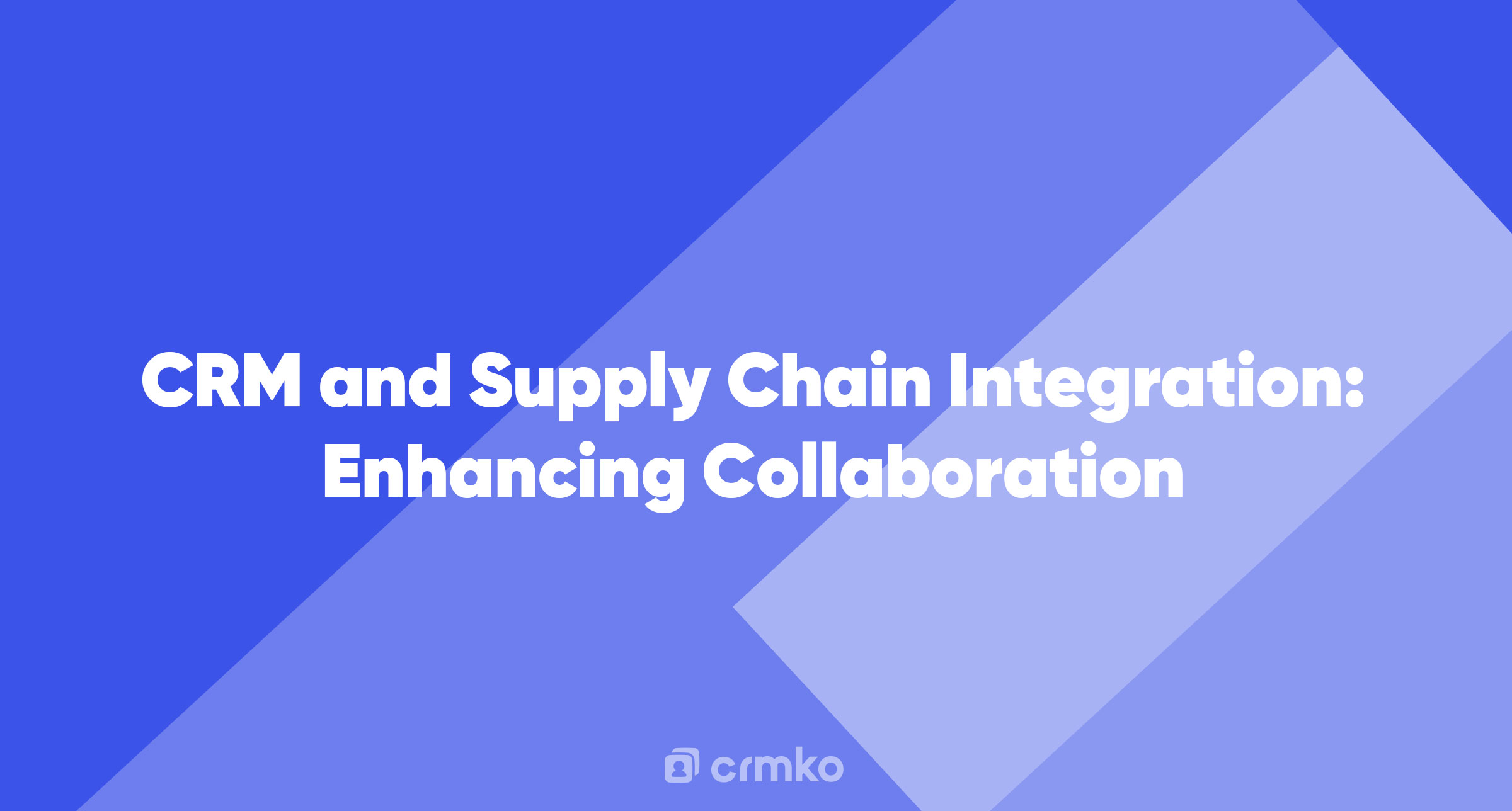How can businesses optimize their supply chain management and improve customer relationship management (CRM) through integration? In this comprehensive guide, we will explore the benefits of CRM and supply chain integration, the different types of integration available, and best practices for successful implementation.
Introduction
In today's highly competitive business landscape, efficient supply chain management and effective customer relationship management (CRM) are crucial for success. But how can businesses ensure seamless collaboration between these two critical areas? The answer lies in CRM and supply chain integration. By integrating CRM systems with supply chain management processes, businesses can streamline operations, enhance collaboration, and improve customer experiences.
CRM integration involves linking multiple software systems and applications to consolidate customer interactions and data across various touchpoints within a business. This integration allows for a more unified and streamlined approach to managing customer relationships. By connecting CRM with other systems such as marketing automation, sales force automation, and social media management tools, businesses can optimize their customer relationship management and enhance customer experiences.
The Benefits of CRM and Supply Chain Integration
CRM and supply chain integration offer numerous benefits that can help businesses achieve their goals more efficiently. Firstly, integration provides businesses with a holistic view of their customers. By bringing together data from various sources, businesses can gain a more complete understanding of customer behaviors, preferences, and needs. This comprehensive view enables businesses to deliver personalized experiences, leading to increased customer loyalty and retention.
Integration also streamlines customer data management. By centralizing customer data in one platform, businesses can avoid duplicates and inconsistencies, leading to improved data accuracy. With accurate data, businesses can make better decisions and execute more targeted marketing campaigns.
Furthermore, CRM integration enhances workflow efficiency. By integrating data from various platforms into one system, businesses can automate processes, reduce manual work, and improve overall efficiency. This automation can result in cost savings and increased productivity.
Finally, CRM and supply chain integration improve the overall customer experience. By integrating customer interaction data such as emails, chats, and social media, businesses can provide a seamless experience for customers. This seamless experience leads to increased customer satisfaction and positive word-of-mouth referrals.
Types of CRM Integration
There are different types of CRM integration that businesses can consider, depending on their specific needs and requirements. These include vertical integration, horizontal integration, and data integration.
Vertical Integration
Vertical integration involves unifying two or more organizations operating at different levels of a supply chain within the same industry. This integration can be forward integration or backward integration. Forward integration involves integrating with downstream suppliers, while backward integration involves integrating with upstream suppliers. Vertical integration helps businesses improve supply chain management, enhance transparency, and reduce the risk of disruptions.
Horizontal Integration
Horizontal integration focuses on integrating multiple internal business functions or departments within an organization. By implementing horizontal integration, businesses can achieve a unified view of their business processes and data. This integration improves communication and collaboration, leading to better customer service and a more streamlined workflow.
Data Integration
Data integration is a critical aspect of CRM integration. It involves consolidating and organizing data from different sources to ensure consistency and accuracy across various systems. Data mapping, synchronization, and security are essential considerations in data integration. This type of integration ensures that businesses have access to reliable and up-to-date customer data.
Best Practices for CRM and Supply Chain Integration
Successful CRM and supply chain integration require careful planning and implementation. Here are some best practices to consider:
- Assess Your Needs: Understand your supply chain management and CRM requirements to identify the stakeholders who will benefit from integration.
- Choose the Right Integration Solution: Select a CRM integration solution that aligns with your organization's goals and integrates seamlessly with your existing systems.
- Customize the Integration: Tailor the integration to meet your specific needs. Define user roles, access permissions, and the information that each stakeholder group can access.
- Work with IT Experts: Collaborate with your IT team or trusted implementation partner to ensure a smooth integration process. Test and validate the integration to ensure data flows seamlessly between systems.
- Train Stakeholders: Provide training to employees, suppliers, customers, and partners on how to effectively use the integrated system. Clear communication and support are crucial for successful adoption.
By following these best practices, businesses can successfully integrate CRM and supply chain management processes, leading to improved collaboration, efficiency, and customer satisfaction.
Conclusion
CRM and supply chain integration is a powerful strategy for businesses seeking to optimize their supply chain management and enhance customer relationship management. By linking CRM systems with supply chain processes, businesses can gain a comprehensive view of customers, streamline operations, and deliver personalized experiences. Vertical and horizontal integration, along with data integration, offer different approaches to integration, each with its own benefits. By following best practices, businesses can successfully implement CRM and supply chain integration, resulting in improved collaboration, efficiency, and customer satisfaction.
With CRM and supply chain integration, businesses can enhance collaboration, optimize processes, and ultimately deliver exceptional customer experiences. As the business landscape continues to evolve, integrating CRM with supply chain management will become increasingly crucial for businesses seeking to stay competitive and thrive in today's market. Embracing CRM and supply chain integration will pave the way for greater success and growth in the future.
Additional Information: CRMJetty's PortalXpand offers a comprehensive solution for businesses seeking a third-party Dynamics 365 portal to enhance their CRM and supply chain integration efforts. With features designed to support all aspects of supply chain management, PortalXpand can help businesses streamline operations, improve collaboration, and deliver exceptional customer experiences.
